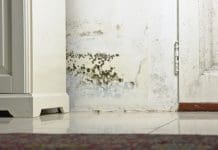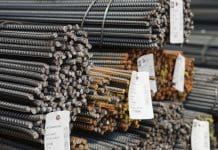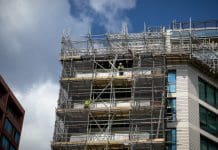Alec Hales, contaminated land specialist at Lucion Environmental, examines the responsibilities associated with reducing asbestos risk on brownfield sites…
The detection of asbestos in soil is becoming a pivotal point in the redevelopment of brownfield sites and contaminated land projects. However, for many developers, the risks associated with asbestos in soil can sometimes be overlooked or underestimated at the desk-top stage. Consequently, asbestos is commonly identified during subsequent ground works or after redevelopment.
The impact of not suitably reviewing, risk assessing and characterising a site for Asbestos Containing Materials (ACMs) can not only significantly increase a project’s duration and cost, but also risk exposure for site workers and local residents. This can lead to RIDDOR reports and HSE involvement, as well as possible criminal prosecution and civil claims.
Asbestos is a category 1 human carcinogen that was extensively used in construction materials prior to the prohibition of its use in the UK in 1999. Asbestos in made ground soils is predominantly immobile, although when contaminated ground soils are disturbed, fibres are more likely to be released. These fibres can be inhaled and potentially cause respiratory diseases. At present, there is no safe exposure threshold for humans and the main risks are associated with breathing in asbestos fibres.
The Control of Asbestos Regulations requires employers to assess any potential exposure to asbestos faced by employees. Quantification of asbestos in soils supports risk assessments in relation to human health exposure, potential re-use and hazardous waste management.
Challenges
Asbestos can find its way into made ground and soils in many different circumstances. These include the historic demolition of buildings containing ACMs, fly tipped waste, earlier use of the site and previously ineffective remediation of areas that may have been suspected as being contaminated.
The following considerations are useful when planning asbestos related fieldwork:
- Are ACMs present at the surface?
- Is there a risk of any release of asbestos fibres into the air?
- Is there a risk of any such release exceeding the control limit for work with asbestos?
- Determine appropriate mitigation methods to reduce potential risks.
- Has previous sampling and analysis been undertaken to determine if asbestos is already present?
Asbestos fibre release from soil depends on multiple factors including:
• ACM type – loose fill, insulation, lagging, Asbestos Insulating Board (AIB), cement etc.
• ACM condition – degraded/ damaged/ broken up.
• Weather and underfoot conditions – wet/ damp or dry, moisture content %.
• Possible erosion of ACMs at surface.
Very low concentrations of asbestos fibres may be present in soil and made ground and these fibres may not be visible to the naked eye. The thorough analysis of soil therefore provides the accurate quantification of any asbestos fibres present as a percentage of the overall mass, and this in turn can be equated to occupational risk and the practices associated with its removal and disposal or re-use.
The control limits stipulate that if the work generates less than 0.6 fibres/cm3 over 10 minutes or less than 0.1 fibres/cm3 over four hours, then it is non-licensed work. If these levels are exceeded, then the work becomes licensed (and the contractor must be a HSE Asbestos Licence holder). In all situations the work must be carried out by suitably trained personnel and companies.
In traditional building surveys there is no requirement to undertake quantitative analysis of asbestos, with the regulations instead focusing on the type of ACM in use rather than the percentage content of asbestos. However, for those involved in the contaminated land sector there are many legal and regulatory obligations that need to be considered in relation to the potential asbestos contamination of soils and made ground.
To meet all regulatory requirements, and to ensure that the potential presence of asbestos in soils is assessed in the required manner, soil samples are assessed in a tiered process to identify if asbestos is present (qualitative analysis), in what composition (asbestos type determination) and in what quantity (quantitative analysis).
Prior to undertaking a site investigation, an initial ‘site pick’ of ACMs at the surface may reduce the likelihood of asbestos fibres being disturbed. However, in order for a sampling strategy to adequately characterise a site for ACMs, soil samples sent for laboratory analysis should be targeted both horizontally and vertically, importantly including visual assessment of excavated soil.
Trial pit and borehole sampling are carried out through the made ground layer on a site or land area and 1 kg (approx 1 litre) of soil is sampled. Careful attention is applied throughout the sample collection and handling in the laboratory to avoid any spread of potential contamination. Trial pits and borehole locations in the site under review are properly reinstated.
This original soil sample is screened for visible asbestos products in the laboratory, which if present are weighed and analysed. Further analysis for asbestos fibres is undertaken and these are also separated and weighed. Measured weights are then scaled back up to represent the whole sample and an overall percentage asbestos content is determined.
On those occasions where asbestos products or fibres are not detected, and subject to a client’s request, further sedimentation analysis can be carried out. This involves a sample of soil being dissolved in water and an aliquot is then passed through a filter. The filter is then analysed using SEM and EDS. If fibres are found, then quantities are measured and scaled up to the original mass and a total asbestos percentage content is reported.
Air monitoring analysis on a contaminated land site is carried out using Phase Contrast Microscopy (PCM). This is the UK standard method for asbestos air monitoring and analysis in accordance with HSG248 Asbestos: The Analysts’ Guide. The PCM method must be carried out by a UKAS accredited testing organisation, and it measures the airborne concentration of fibres that have consistent dimensional properties (i.e. within correct range of width / length) to those of respirable asbestos fibres.
A PCM test does not, however, discriminate between asbestos and non-asbestos fibres – all fibres fitting the correct criteria are counted. As such, other “background” non-asbestos fibres are a possible component of the result. However, in situations where there are known sources of interference fibres, such as organic machine-made mineral fibres (MMMF), Scanning Electron Microscopy (SEM) UKAS accredited laboratory testing may be appropriate to conduct further assessment given the ability to achieve a higher sensitivity (i.e. lower limit of detection) more appropriate to environmental monitoring.
The ‘wonder’ mineral of over 50 years ago continues to leave a lasting legacy that carries considerable health risks. To minimise this risk it is vital that all those with a responsibility for the management of asbestos, or who could potentially come into contact with it during building works, should have the right knowledge, training and support to deal with it safely. ■
. . . . . . . . . . . . . . . . . . . . . . . . . . . . . . . . . . . . . . . . . . . . . . .
Alec Hales
Contaminated Land Specialist
Lucion Environmental
Tel: 0191 461 8999
enquiries@lucion.co.uk













![[VIDEO] Using digital twins to simplify complex fire barrier assessment Read more about how Trident Fire Protection utilised digital twin technology to conduct a fire barrier assessment in a complex space with tight areas and poor access in a roof void](https://www.pbctoday.co.uk/news/wp-content/uploads/2024/08/Trident-complex-roof-area-218x150.png)